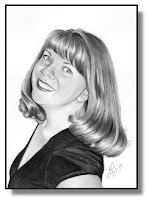Deciding where to crop each person really depends upon how many are in the portrait and your drawing style. Head and shoulders are a good place to end the drawing on each person when you have 5 or more subjects to draw. However, I have made a five person portrait (as seen to the right) showing hands and waist simply to show "togetherness". Looking close at this portrait, you will see everyone is touching someone else. This special portrait is 11x14 graphite on Bristol smooth.
Recently, I had the opportunity to draw a ten person portrait (to the left). This was a large piece, 16x20, was rendered with graphite on Bristol smooth, and took nearly 100 hours to complete.
Almost every person was taken from a separate photo. How do you get everyone to have the right size head? Here is a neat trick, you can use any photo editor where you can make layers on the file. Each person is added on a separate layer and the distance between the pupils are sized to match. It may not be true that the distance between pupils are the same for everyone, but it serves as a pretty good guide.
When drawing large family portraits, I also like to have everyone in the same general attire. For this ten person portrait I received permission from my client to have everyone in formal attire, though not every person was in formal attire. It truly helps to complete the flow of the portrait.
My most recent piece was another large family portrait which had had five people. Though this may not sound like a lot, but it becomes challenging to arrange five people symmetrically. Odd number, difficult to place. I started this portrait with the mother and father at the bottom and arranged the children in a triangle above them. This arrangement did not work well because the children seemed to be "floating" in the air above their parents. Finally, I came up with the arrangement you see here and I was very pleased, as was the owner.
A banner can be used at the bottom of large family portraits as a way to tie everyone together, as seen in this portrait. The owner wanted the family name in a banner and the words "Established 1993". After many tries of putting the entire wording inside the banner, I found that some of the wording looked just as nice, if not better below the banner. When you put wording on a portrait, keep in mind you want to be able to read it from several feet away. This way, if it is placed above a fireplace and you are six feet away, you will still be able to read it.
Drawing large family portrait can be intimidating, but if you take the time to carefully arrange the layout before putting your pencil to paper, you can eliminate a lot of time and rework stress.








